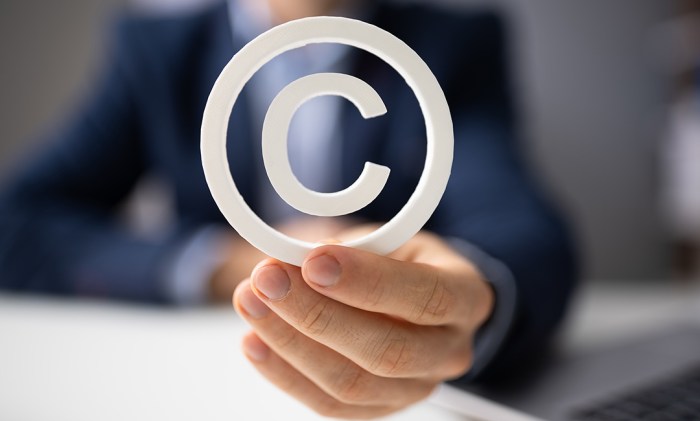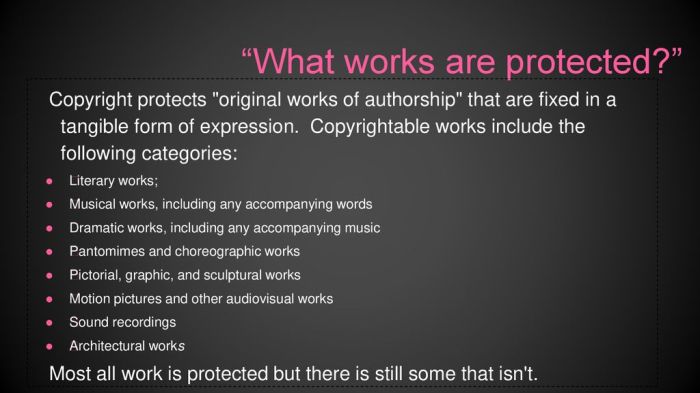Works that are copyrightable include product packaging, a crucial aspect of branding and marketing. Copyright law provides protection for the unique designs, logos, and artwork that adorn product packaging, safeguarding the intellectual property of creators and businesses.
This comprehensive guide delves into the intricacies of copyright protection for product packaging, exploring the criteria for determining copyrightability, distinguishing between copyrightable and non-copyrightable elements, and providing practical guidance on copyright registration and enforcement.
Elements of Product Packaging that Qualify for Copyright Protection
Copyright law extends protection to original works of authorship, including artistic and literary expressions. In the context of product packaging, several elements can qualify for copyright protection, provided they meet the criteria of originality and creativity.
The key elements that may be protected include:
- Original designs:Unique and distinctive packaging designs, including the overall shape, structure, and arrangement of elements.
- Logos and trademarks:Distinctive marks, symbols, or words that identify the product or brand.
- Artwork and illustrations:Original artwork, drawings, or photographs that enhance the packaging’s aesthetic appeal.
- Typography and lettering:Unique and artistic use of fonts, typefaces, and lettering.
- Color combinations and patterns:Distinctive color schemes and patterns that create a recognizable and visually appealing package.
Examples of iconic product packaging that have received copyright protection include the Coca-Cola bottle, the Apple iPod packaging, and the Tiffany & Co. blue box.
Distinguishing Copyrightable from Non-Copyrightable Elements: Works That Are Copyrightable Include Product Packaging

Not all elements of product packaging are eligible for copyright protection. The distinction lies in the concept of “functionality” versus “artistry.” Functional elements, which serve a primarily utilitarian purpose, are not subject to copyright protection.
Examples of non-copyrightable elements include:
- Structural features:Elements necessary for the packaging’s functionality, such as the shape of a bottle or the closure mechanism.
- Generic designs:Common and widely used packaging designs that lack originality.
- Product information:Facts, descriptions, and instructions related to the product itself.
- Color choices:Basic and commonly used colors that do not contribute to the artistic or aesthetic value of the packaging.
Copyright Registration and Enforcement
Registering a copyright for product packaging is not mandatory but provides several benefits. Registration creates a public record of ownership, establishes a presumption of validity, and allows for statutory damages in case of infringement.
To register a copyright, the applicant must submit a completed application form, a non-refundable filing fee, and a copy of the work to the Copyright Office.
Enforcement of copyright rights involves pursuing legal action against infringers. This can include filing a lawsuit, seeking an injunction to prevent further infringement, and recovering damages.
Fair Use and Exceptions to Copyright

Fair use is a legal doctrine that allows limited use of copyrighted material without the need for permission from the copyright holder. In the context of product packaging, fair use may apply in situations such as:
- Criticism or commentary:Using copyrighted packaging in a critique or analysis of the product or brand.
- Parody or satire:Creating a parody or satire that incorporates copyrighted packaging elements.
- Education or research:Using copyrighted packaging in a non-commercial educational or research setting.
Case Studies and Legal Precedents

Several notable legal disputes have shaped the interpretation of copyright law in the context of product packaging. These cases provide guidance on the boundaries of protection and the application of fair use.
One significant case is the Supreme Court decision in Dastar Corp. v. Twentieth Century Fox Film Corp. (2003). The Court held that functional elements of product packaging are not subject to copyright protection.
Another notable case is the Second Circuit decision in Star Athletica, L.L.C. v. Varsity Brands, Inc. (2017). The court ruled that the unique design of a cheerleading uniform, including the arrangement of colors and stripes, was copyrightable.
Emerging Trends and Best Practices
The digital landscape and evolving consumer behavior are shaping new trends in copyright law and product packaging. Designers must stay abreast of these trends to avoid infringement and protect their intellectual property.
Best practices for packaging designers include:
- Conduct thorough research:Understand the existing market landscape and identify potential areas of infringement.
- Create original designs:Focus on creating unique and distinctive packaging designs that set your products apart.
- Seek professional advice:Consult with an attorney to ensure your packaging designs comply with copyright laws.
- Consider registering your copyright:Registering your copyright provides additional protection and benefits.
Essential FAQs
What are the criteria for determining copyrightability in product packaging?
Copyrightability is determined by the originality and creativity of the design, as well as its fixed expression in a tangible form.
What types of packaging elements are not eligible for copyright protection?
Functional elements, such as the shape or size of the packaging, are not copyrightable. However, artistic elements, such as logos or artwork, may be protected.
How can I register a copyright for product packaging?
Copyright registration can be obtained through the Copyright Office, providing legal proof of ownership and facilitating enforcement.
What are the exceptions to copyright law that may apply to product packaging?
Fair use allows limited use of copyrighted material without permission for purposes such as criticism or education.